How to Stop Shoes from Squeaking on Hard Floors?

Have you ever been trying to stealthily navigate a quiet room, only to be betrayed by the unmistakable squeaking sound from your shoes?
The frustration and embarrassment of squeaky shoes on hard floors can be all too familiar.
Those squeaks can disrupt the tranquility and draw unwanted attention, whether attending an important meeting, walking down a quiet hallway, or enjoying a peaceful moment at home.
In this guide, we’ll explore the causes of shoe squeaking and provide practical solutions to help you silence your steps. From quick fixes to in-depth remedies, we’ll equip you with the knowledge to eliminate those annoying squeaks.
Let’s embark on the journey together to find the solution to “How to Stop Shoes from Squeaking on Hard Floors” and end shoe squeaking, one step at a time.
Understanding the Causes of Shoe Squeaking
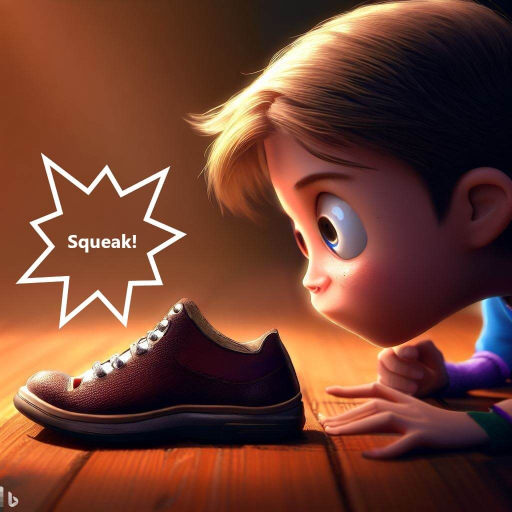
Let’s uncover the typical culprits behind shoe squeaking and how to address them.
– New Shoes:
It’s not uncommon for brand-new shoes to squeak on hard floors. Why? Fresh out of the box, shoes may have stiff materials and finishes, especially around the soles and the upper part.
As you break them in, the squeaking should subside.
But if it doesn’t, don’t worry! We have other solutions for quieting those new kicks.
– Trapped Air and Moisture:
Ever notice how your shoes can get squeaky when your feet are sweaty or after walking in the rain? Moisture, whether from your perspiration or external sources, can create a slippery barrier between the shoe and the floor, resulting in those unpleasant noises.
Additionally, air trapped within the shoe can cause squeaks. The air is especially trapped, as pockets, under the insole (usually removable) and ejects while you walk to cause the noise.
– Rubber Soles:
While rubber soles are often touted for their durability and grip, they can sometimes contribute to shoe squeaking.
The high friction between the rubber sole and certain hard floor surfaces, including tiles, linoleum, waxed and rubberized floors, can produce squeaky noises with every stride.
– Wear and Tear:
As shoes endure the wear and tear of daily use, various components can become loose or worn out. This includes the insoles, outsoles, and other structural elements. When these elements no longer fit snugly or interact properly, they can create friction and produce squeaks.
– Water Damage:
Water and shoes don’t always mix well. If your shoes get soaked and don’t dry properly, the moisture can seep into the shoe’s components, causing them to warp, weaken, or become misaligned. This can cause the components to rub together and squeak when you wear them.
– Something May Be Stuck on the Sole:
Sometimes, a foreign object like a pebble, gum, or even a small piece of debris can get lodged in the treads of your shoe’s sole.
As you walk, this foreign object can create a squeaking noise against the hard floor, especially linoleum floors.
– Lace Problem:
Believe it or not, even your shoelaces can be the source of squeaking. If the laces are too loose or rubbing against certain shoe parts, like eyelets, they can create friction and generate that dreaded noise.
– Your Shoes Don’t Fit Properly:
Ill-fitting shoes can cause more than just discomfort. When your shoes are either too tight or too loose, they can lead to rubbing and movement within the shoe, resulting in squeaking noises as you walk.
– You’re Not Wearing Your Shoes the Right Way:
It’s hard to believe, but how you wear your shoes can also affect their propensity to squeak. If you wear certain shoes, especially leather shoes, without socks or with improper sock materials, the lack of cushioning and increased friction can generate those unwelcome noises.
– Poor Shoe Quality:
Sometimes, the culprit behind squeaky shoes lies in the quality of the footwear itself. Shoes made with subpar materials or shoddy craftsmanship may have loose or misaligned components, leading to persistent squeaking.
How to Stop Shoes from Squeaking When Walking?

Now that we understand the causes behind those squeaky steps. Let’s dive into some practical techniques to silence your shoes on hard floors.
From quick fixes to more in-depth solutions, we’ve got you covered.
Let’s start off with the overall solutions if you don’t know exactly what shoe part is causing the squeaking.
How To Stop Shoes From Squeaking? – General Solutions
1) Examine The Shoes:

Look closely at your shoes and check for any loose or damaged components. Inspect the insoles, outsoles, laces and other shoe parts to identify any areas contributing to the squeaking.
Real-life tip: Grab a flashlight and examine your shoes in a well-lit area. Look for loose stitches, separated outsoles, or worn-out insoles that may need attention.
You must also pay attention to anything stuck within the outsole’s lugs, grooves, or treads. It can be a pebble, rock, or thumb pin that produces sound when you walk on hard floors, especially tile, linoleum, or waxed floors. If you find anything stuck, remove it using a screwdriver.
However, if you don’t find any damage, loose parts, or anything stuck, then it’s most probably a shoe material or design problem. You can take your shoes to the cobbler or try the methods ahead to fix it.
2) Wear Your New Shoes

If you have a new pair of shoes, including Nike shoes, tennis shoes, and leather shoes, that are squeaking, you shouldn’t be tweaking them right away.
Instead, you can try wearing them around the house, and even outdoors, for a few days to see if the squeaking goes away on its own.
This is because new shoes often have a protective coating on the soles that can cause them to squeak. As you break them in, the sole and other materials and components will gradually adjust and conform to your feet, reducing friction and eliminating squeaking.
If you’re looking for an answer to “how to stop new shoes from squeaking” and this method didn’t work for you, don’t worry! We have several other solutions that can help you eliminate that annoying noise. Keep reading to find out more.
3) Dry Your Shoes
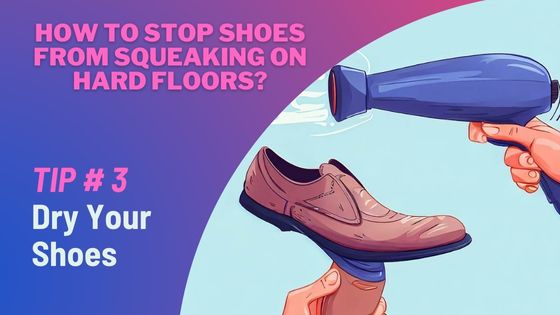
Most of the time, drying your shoes properly is the key to keeping them silent and ensuring a smooth, noise-free stride.
Here’s what you need to do, especially if you were searching for “how to stop shoes from squeaking on tile“:
- Say no to wet shoes: Moisture is the arch-enemy of silence. So, when your shoes get wet, don’t wait for them to air dry naturally. Take action! Grab a clean cloth, cotton balls, or paper towel and gently blot away the excess moisture.
- Air it out: Give your shoes some breathing space. Remove the insoles and any inserts and let them all air out separately. This allows air to circulate and evaporate any lingering moisture that might be hiding in the nooks and crannies.
- Use the sun’s power: Mother Nature is the natural dryer that can work wonders! Find a sunny spot outdoors and place your shoes to soak the sun’s warmth. The sunlight acts as a natural dehumidifier, ensuring your shoes dry thoroughly from the inside out.
Bonus tip: Flip your shoes over halfway through for an even sun-drying process. - Speed up the process: If you’re in a hurry to silence those squeaks, you can employ some extra help. Insert newspaper, tissue paper, or paper napkins inside the shoe, and consider using a shoe dryer or even a fan or a hairdryer on the lowest heat setting. You can also place your shoes in front of a radiator. This accelerates the drying process and keeps those squeaky sounds at bay. Another method that works particularly for canvas or fabric shoes is to put them in the cloth dryer. However, this is not recommended for leather shoes.
- Give them time to breathe: Once your shoes are dry, it’s essential to give them ample time to breathe before wearing them again. Allow at least 12 hours for the shoes to air out and eliminate any remaining moisture fully.
Note: Leather shoes may shrink and crack if they are fully dried. They need a small amount of moisture to keep them in good condition. While implementing the steps above, you must apply a leather conditioner (while leather shoes are damp) to retain/restore the required moisture.
4) Waterproof Your Shoes
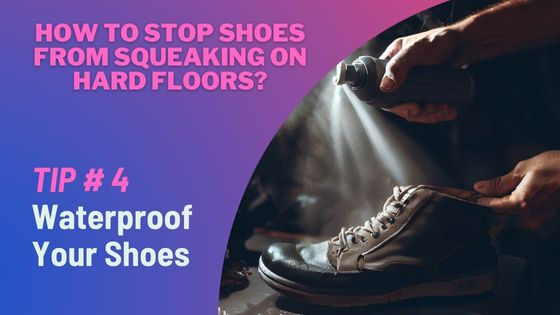
If your shoes are not waterproof, they can start to squeak when they get wet.
To prevent this from happening, you can waterproof your shoes using a waterproofing spray or wax.
Here’s how:
- Clean your shoes thoroughly with a damp cloth.
- Let them dry completely.
- Apply the waterproofing spray or wax according to the manufacturer’s instructions.
- Let the shoes dry completely before wearing them again.
Following these steps can also help prevent your shoes from squeaking due to moisture on hard floors like linoleum floors, waxed floors, and tiles.
This method works for shoes with solid uppers, including leather, and some canvas, and fabric shoes. However, shoes with mesh fabric cant be waterproofed.
Now that we have discussed overall methods let’s jump to fixing the squeaky insoles.
5) Fix the Broken Parts:
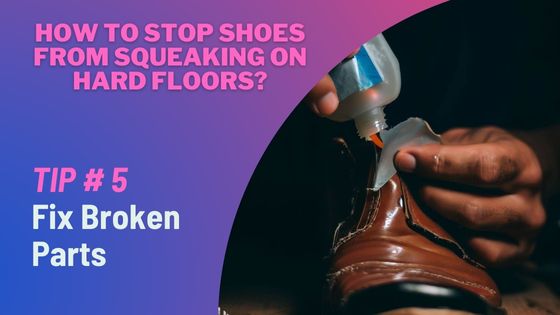
Due to excessive usage and wear and tear, various shoe parts tend to lose, which rub together to cause an irritating squeaking sound.
So, if your shoes are squeaking due to broken or loose parts, such as detached outsole, displaced insole, separated seams, or damaged components like eyelets or heel caps, super gluing them back together can help eliminate the noise and restore the shoe’s integrity.
Here are the steps you can follow to glue the broken parts of your shoes to stop them from squeaking:
- Assess the Damage: Examine your shoes carefully to identify the broken or loose parts causing the squeaking.
- Clean and Prepare the Surfaces: Before applying any adhesive, clean the broken surfaces to remove dirt, dust, and any remnants of old glue.
- Choose the Right Adhesive: Select an adhesive suitable for your working materials. Depending on the type of damage, a strong and flexible adhesive like shoe repair glue, epoxy, or a specific adhesive recommended for the shoe material may be required.
- Apply the Adhesive: Following the manufacturer’s instructions, apply a thin layer of adhesive to both surfaces that need to be bonded. Ensure the entire area is covered evenly using a small brush or the applicator provided with the adhesive.
- Press and Hold: Carefully align the broken parts and press them firmly together. Apply consistent pressure for sufficient time to allow the adhesive to bond properly. You can use clamps, rubber bands, or even your hands to hold the parts while the adhesive sets.
- Allow the Adhesive to Cure: Refer to the adhesive’s instructions for the recommended curing time. Letting the glue dry and set undisturbed for the specified duration is crucial. Avoid wearing the shoes or putting any stress on the repaired areas during this time.
- Test the Shoes: Once the adhesive has fully cured, try on the shoes and walk around to test if the squeak has been eliminated. The repaired parts should now be securely bonded, preventing any movement or friction that can cause the noise. If the squeak persists, reassess the repair or consider seeking professional assistance.
Remember, the effectiveness of gluing broken parts to stop shoe squeaking may vary depending on the severity and nature of the damage. In some cases, professional shoe repair might be the best option to ensure a proper and long-lasting fix.
By taking the time to repair and glue the broken parts of your shoes, you eliminate the annoying squeak and extend the lifespan of your favorite footwear. With proper care and maintenance, your shoes can continue providing comfort and functionality for many more steps.
6) Wear Socks
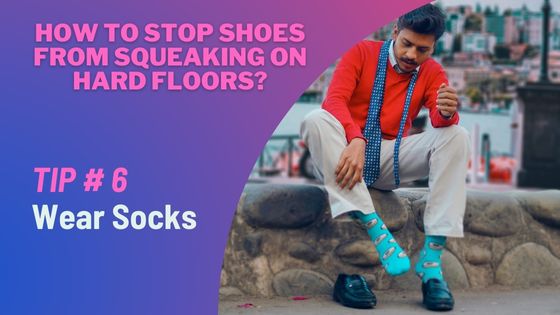
Maybe your shoes are squeaking due to friction between your feet and the insole. You can try wearing socks to stop the noise.
Socks can help reduce friction and absorb moisture, which can help prevent squeaking.
If you don’t like wearing socks with your shoes, you can try using no-show socks or footies. These are low-cut socks that won’t show when you’re wearing your shoes.
Wearing socks is a simple and effective way to eliminate squeaking shoes. Plus, it can help keep your feet dry and comfortable throughout the day.
7) Wear Your Shoes Properly
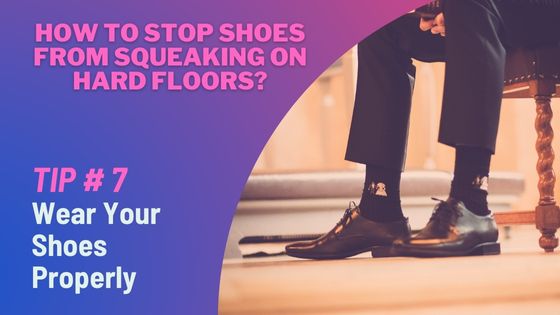
Your shoes can squeak due to improper wear. So, you can try adjusting how you wear them to stop the noise. Here are some tips:
- Make sure your shoes fit properly. Shoes that are too tight or too loose can cause squeaking.
- Wear socks with your shoes to reduce friction and absorb moisture.
- Walk with a normal gait. If you’re dragging your feet or walking abnormally, it can cause squeaking.
- Don’t force yourself to fold your shoe back and wear it. It can damage your shoes permanently and cause squeaking while walking.
By wearing your shoes properly, you can help prevent squeaking and extend the life of your shoes.
8) Take your shoes to the cobbler

If you’ve tried all the DIY methods and your shoes are still squeaking, it might be time to take them to a cobbler. A cobbler is a professional who specializes in repairing shoes and can help you eliminate that annoying squeak.
When you take your shoes to the cobbler, they’ll inspect them to determine the cause of the squeaking. They might need to replace the insole or midsole, tighten screws or bolts, or apply lubricant to the shoe’s moving parts.
While taking your shoes to the cobbler might cost more than a DIY solution, it’s often worth it if you have a favorite pair of shoes you want to keep wearing for years.
How to Stop My Shoe Insoles from Squeaking?
1) Use Baby Powder, Talcum Powder, or Corn Starch
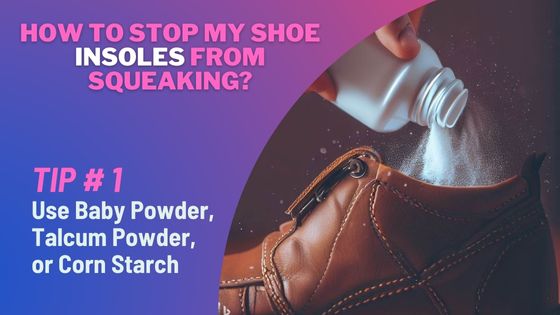
Are your favorite shoes still making an annoying squeaking sound after trying the methods above?
Don’t worry! There’s another simple and inexpensive solution to silence those squeaky shoes.
Using baby powder, talcum powder, or corn starch, you can eliminate the irritating noise and enjoy walking peacefully.
Here’s how to use these household items to stop your shoes from squeaking:
- Identify the Source of the Squeak: Locate the exact area where the squeaking is coming from by flexing and twisting the shoe gently in your hands or walking around and listening closely to pinpoint the noise.
- Clean the Shoe: Remove any dirt, debris, or moisture from the shoe’s surface. Wipe it with a clean cloth or brush to ensure the powder adheres properly.
- Apply Baby Powder or Corn Starch: Sprinkle a small amount of baby powder or corn starch directly onto the insole or in the problem area where the noise originates. If the squeak comes from the sole, you can lift the insole and sprinkle the powder underneath.
- Distribute the Powder: Once you’ve applied the powder, gently tap and shake the shoe to distribute it evenly. Ensure the powder reaches all the nooks and crannies where friction is causing the squeaking sound.
- Work the Powder into the Shoe: Use your hands to massage the powder into the shoe’s surface or problem area. This will help the powder penetrate deeper, reducing friction, releasing trapped air, and eliminating the squeak.
- Remove Excess Powder: Tap or shake off any excess after working the powder into the shoe. You want to ensure that the powder is evenly distributed inside the shoe without leaving any visible residue on the exterior.
- Test the Shoes: Put your shoes back on and take a few steps to test if the squeak has been eliminated. In most cases, the powder’s lubricating effect should have minimized the friction, resolving the squeaking issue. If the noise persists, you may need to repeat the process or try an alternative solution.
- Reapply as Needed: The powder may lose effectiveness over time, especially if it gets absorbed or wears off. If the squeak returns, simply reapply the baby powder or corn starch using the abovementioned steps.
2) Glue the Inner Sole to the Midsole

If you’ve tried using baby powder or corn starch to no avail, or if the squeaking sound is specifically coming from the area between the inner sole and the midsole of your shoes, gluing them together can be an effective solution.
By securing these layers, you can eliminate the movement and friction that causes the annoying squeak.
Here are steps on how to glue the inner sole to the midsole of your shoes:
- Clean the Surfaces: Ensure that the inner sole and the midsole are clean and free of dirt, dust, or any debris that may hinder the adhesion process. Use a damp cloth or sponge to wipe down the surfaces and let them dry completely.
- Choose the Right Adhesive: Select an adhesive suitable for bonding materials commonly found in shoes, such as rubber, leather, or fabric. A strong and flexible adhesive like shoe repair glue, super glue, or clear epoxy is often recommended.
- Apply the Adhesive: Following the manufacturer’s instructions, apply a thin, even layer of adhesive to either the inner sole or the midsole, depending on which surface is more accessible. Be sure to cover the entire area where the two layers come into contact.
- Press and Secure: Press the inner sole and the midsole together firmly, aligning them properly. Apply pressure evenly across the entire surface to ensure a strong bond. You can use clamps, heavy books, or even place a weight on top of the shoe to hold the layers in place while the adhesive sets.
- Allow the Adhesive to Cure: Refer to the adhesive’s instructions for the recommended curing time. Let the glue dry and set it undisturbed for the specified duration. Avoid wearing the shoes or putting any stress on the bonded area during this time.
- Test the Shoes: Once the adhesive has fully cured, try on the shoes and take a few steps to check if the squeak has been eliminated.
3) Moisturize the Inside of the Shoe
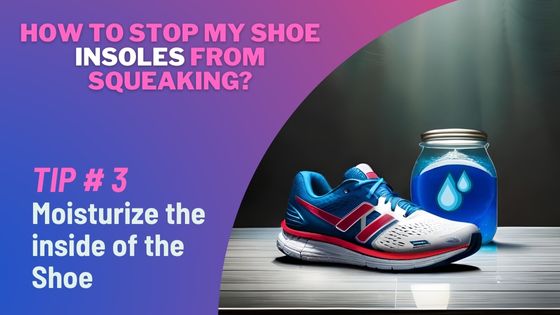
There is a high chance that your shoes, especially leather shoes, are squeaking due to dryness or friction between the materials. Therefore moisturizing the inside can be an effective solution to reduce the noise.
Adding moisture lets you lubricate the surfaces, minimizing the friction that causes the squeaking sound.
Here are the steps you can follow:
- Identify the Squeaking Areas: Determine where the squeak originates inside the shoes. It could be the insole, lining, or any other part that comes into contact with your feet. If it’s insole, you need to remove it before lubrication.
- Clean the Inside: Before moisturizing, ensure that the inside of the shoes is clean and free from dirt or debris.
- Choose a Moisturizing Agent: Select an appropriate moisturizing agent that is safe for the shoe material. Some suitable options include leather conditioners, petroleum jelly (Vaseline), coconut oil, lanolin-based products, or even a small amount of hand lotion.
- Apply the Moisturizer: Take a small amount of the moisturizing agent and apply it to the areas inside the shoes where the squeaking occurs. Use your fingers or a soft cloth to spread the moisturizer evenly, covering the entire surface.
- Massage and Distribute: Once the moisturizer is applied, gently massage it into the material. This will help distribute the moisture and ensure it penetrates into the fibers of the shoes. Focus on the squeaking areas and any other dry or stiff sections.
- Remove Excess Moisturizer: Remove any excess moisturizer with a clean cloth after massaging. You want to leave enough moisture to lubricate the surfaces without causing any excess buildup or stickiness to ruin your socks.
- Let the Shoes Rest: Allow the shoes to rest for a few hours or overnight, giving the moisturizer ample time to absorb the material. Place the shoes in a well-ventilated area to aid in the drying process.
- Test the Shoes: Put on the shoes and walk around to test if the squeaking has been reduced or eliminated. If necessary, repeat the process or try alternative solutions.
Note: As leather shoes are made of animal skin, they require regular lubrication through a leather conditioner to maintain their shape. Therefore, even after the leather shoe squeaking is fixed, you must apply the conditioner at least once a month.
4) Use Silica Gel or Other Moisture Absorbent
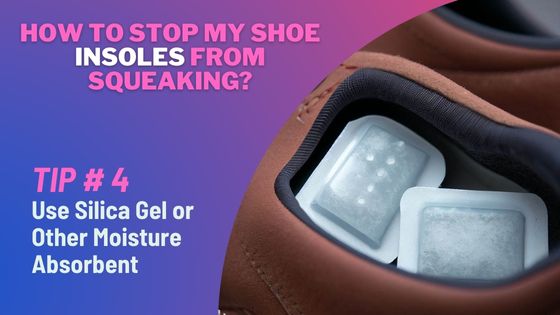
This method can work if you are searching for “how to stop shoes from squeaking on linoleum.”
In summer, your shoe collects much moisture due to excessive sweating. This moisture traps inside the shoe and causes a bad odor and squeaky noise.
Using moisture absorbents such as silica gel or activated charcoal is a helpful solution to stop shoes from squeaking due to excess moisture or sweat buildup.
Begin by identifying the squeaking areas and ensuring the shoes are clean and overall dry. Place moisture absorbents, like silica gel packets, inside the shoes overnight to allow them to absorb excess moisture.
Remove the absorbents and test the shoes to see if the squeaking has been reduced or eliminated.
5) Insert a Papersheet Under the Insole
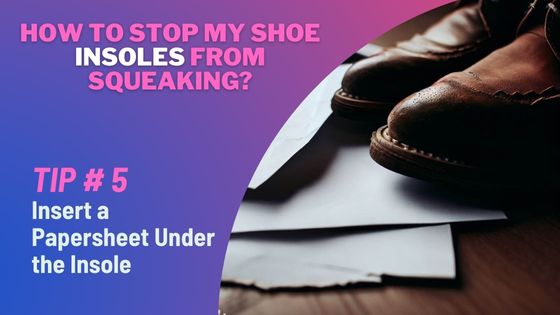
Sometimes the space between the insole and the shoe sole causes the squeaking noise. The air trapped in the space is pushed out while walking to produce an irritating sound.
Although you can counter this problem by gluing the insole and midsole together, you can also fill the space by placing a paper sheet between the insole and the midsole.
- Make sure your shoes and the paper sheets are fully dried
- Simply remove the insole from your shoe
- Place the insole on the paper sheet, and trace its borders using a marker or pencil.
- Cut out the paper sheet as per the marking to get it in the same size and shape as an insole.
- Place the paper sheet inside the shoe, followed by the insoles, back to their place.
You can also use paper towels, dry sheets, or napkins instead of paper-sheet. However, you must ensure these sheets are changed after a few days and may deteriorate due to sweat from your feet.
Quick Tip!
Sometimes simply picking up the shoe and massaging the insole to get out trapped air bubbles can fix the squeaking problem.
How To Stop the Bottom Of The Shoes From Squeaking?
1) Sand the Bottom of the Shoe
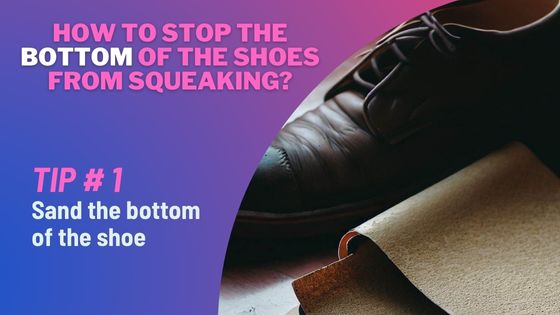
Shoes with rubber or leather outsoles are more likely to squeak than other shoes.
Besides, if you’ve just bought a new pair of shoes, they might squeak due to the extra-smooth and polished outsole.
On the other hand, if you have an old pair of shoes, they might squeak due to rough or uneven soles.
No matter what is the reason, Sandpaper could be the solution.
Here’s how:
- Use a piece of sandpaper to sand the bottom of the sole.
- Sand until the sole is smooth and even.
- Use warm water to wash away the sand and dry the sole with a cloth.
Sanding the bottom of your shoe can help reduce friction and prevent squeaking. Just be careful not to sand too much, or you might damage your shoes.
Note: You will need sandpaper between 120 grit to 220 grit. You can find it easily in hardware stores or online.
2) Use Rubber Sole Spray

If the above-mentioned methods aren’t working for you and you are still looking for an answer to “how to stop rubber shoes from squeaking“, try using rubber sole spray.
This simple and effective solution can help you eliminate the squeaking problem quickly. Here’s how to use it:
- Clean the sole of your shoes with a damp cloth or a brush to remove any dirt or debris.
- Shake the can of rubber sole spray well before using it.
- Hold the can about 15 cm away from the outer sole of your shoes and spray a thin and even coat on the entire surface. Avoid spraying too much or too close, which might cause dripping or unevenness.
- Let the spray dry for about 15 minutes or until it feels tacky to the touch. You can use a hair dryer to speed up the drying process if you are in a hurry.
- Test your shoes by walking on a hard floor and listening for any squeaking sounds. If you still hear some noise, you can apply another coat of spray and repeat the process until you are satisfied with the result.
- Enjoy your squeak-free shoes and walk with confidence and comfort!
Note: You can also use WD-40 if you can’t access Rubber Sole Spray.
3) Rub the Bottoms of your Shoes with a Dryer Sheet

Another simple and quick way to get rid of shoe squeaking is to rub the bottoms of your shoes with a dryer sheet.
A dryer sheet is a thin, soft fabric coated with a substance that reduces static electricity and softens clothes.
Here are the steps on how to use a dryer sheet to get rid of shoe squeaking:
- Take a fresh dryer sheet out of the box and unfold it.
- Hold the dryer sheet and rub it on the bottom of your shoes. Make sure to cover the sole’s entire surface, especially the areas most prone to squeaking, like the heel.
- Repeat the process for the other shoe.
- Put on your shoes and walk around to test them for any squeaking sounds. If you still hear some noise, rub the dryer sheet on your shoes again or try a different method.
- Bonus: You can also place the dryer sheet between the insole (if removable) and the shoe to fill up the space and eliminate the squeaking.
However, rubbing the dryer sheet is a temporary solution, and you might want to repeat this method every time you go for a walk.
4) Replace the Laces

Sometimes, the source of the squeaking sound in your shoes is not the sole but the laces.
You can replace the laces with new ones to reduce friction and noise and adjust your shoes’ fit and comfort.
Replacing the laces is easy and fun to do. You just need to buy new laces that match the size and style of your shoes and follow these steps:
- Remove the old laces from your shoes by untying them and pulling them out of the eyelets.
- Take one new lace and insert it into the bottom pair of eyelets on your shoe. Make sure to leave equal lengths of lace on both sides.
- Cross the laces over each other and insert them into the next pair of eyelets on your shoe. Repeat this process until you reach the top pair of eyelets.
- Tie the laces in a knot or a bow, as you prefer.
- Repeat the process for the other shoe.
- Put on your shoes and walk around to test them for any squeaking sounds. If you still hear some noise, you can try adjusting the tightness or looseness of your laces until you achieve the desired result.
5) Apply Saddle Soap to the Tongue of the Shoe

Another possible cause of squeaking is the shoe’s tongue.
The tongue is the flap of material that covers the top of your foot and lies under the laces. The tongue can rub against the laces or the inside of your shoes, creating irritating noises every time you walk.
If true, you might want to apply saddle soap to the tongue.
Here’s why and how!
Saddle soap is a product that is used to clean and condition leather. It can help you eliminate shoe squeaking by moisturizing and softening the tongue of your shoes.
Saddle soap is easy to apply and effective. You just need to buy a tin of saddle soap from a shoe store or online and follow these steps:
- Remove the laces from your shoes by untying them and pulling them out of the eyelets.
- Take a damp cloth or a sponge and rub it on the saddle soap to create a lather.
- Apply the lather to the tongue of your shoes, covering it completely with a thin layer of soap.
- Let the soap dry for about 10 minutes or until it feels tacky.
- Wipe off any excess soap with a clean cloth or a sponge.
- Re-lace your shoes and put them on.
- Walk around to test them for any squeaking sounds. If you still hear some noise, apply more saddle soap or try a different method.
6) Drag Your Feet on the Concrete Floor
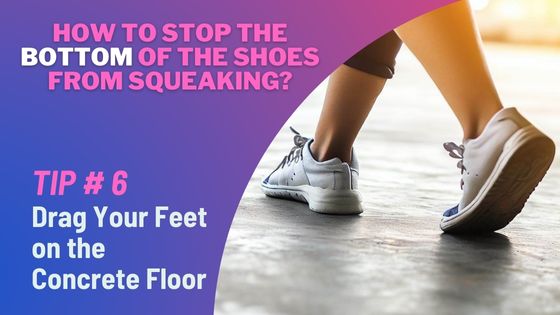
This one can also work for those searching for “new shoes squeak when I walk.“
Yes, you read that right. Dragging your feet on the concrete floor can reduce or eliminate the squeaking noise of your shoes.
How does it work? Well, the squeaking is usually caused by friction between the rubber sole of your shoe and the smooth floor.
You create tiny scratches on the rubber sole by dragging your feet on the concrete floor, reducing friction and noise.
Of course, this method has drawbacks. First, it can damage your shoes and make them wear out faster.
Second, it can make you look silly and unprofessional, especially in a formal setting.
Third, losing your balance or tripping over something can be dangerous. So, use this trick with caution and only when necessary.
Suppose you want a more permanent solution to your squeaky shoes. In that case, you can try other methods, such as applying baby powder, WD-40, or leather conditioner to the sole of your shoe or replacing the insole with a thicker or softer one.
These methods can help lubricate the sole and prevent it from rubbing against the floor.
But dragging your feet on the concrete floor can be handy if you’re in a hurry and need a quick fix. Just ensure you don’t do it too often or hard, or you might end up with no shoes!
Conclusion
Throughout this guide, we’ve explored the frustrating world of shoe squeaking on hard floors and provided practical solutions to help you silence your steps.
We examined various causes of shoe squeaking, including inadequate cushioning, moisture-related factors, loose or damaged components, poor shoe quality, and improper shoe fit.
We delved into techniques to eliminate shoe squeaking, like using talcum powder or dryer sheets.
Now that you have a range of techniques, we encourage you to take action and try the suggested solutions.
Experiment with different approaches, be patient during the breaking-in process and find what works best for you and your shoes.
Remember, each step towards a squeak-free experience brings you closer to enjoying quiet and confident strides.

![New Balance Heel Drop Chart [2024 Updated]](https://bestfashionnova.com/wp-content/uploads/2023/09/new-balance-Heel-Drop-Chart.jpg)
![Saucony Heel Drop Chart [2024 Updated]](https://bestfashionnova.com/wp-content/uploads/2023/10/Saucony-Heel-Drop-Chart.jpg)
![Adidas Heel Drop Chart [2024 Updated]](https://bestfashionnova.com/wp-content/uploads/2023/09/Adidas-Heel-Drop-Chart.jpg)
![ASICS Heel To Toe Drop Chart [2024 Updated]](https://bestfashionnova.com/wp-content/uploads/2023/09/ASICS-Heel-Drop-Chart.jpg)
![Running Shoes Heel Drop Chart [2024 Updated]](https://bestfashionnova.com/wp-content/uploads/2023/07/A-blog-post-banner-with-title-running-shoes-heel-drop-chart.jpg)
![Altra Heel To Toe Drop Chart [2024 Updated]](https://bestfashionnova.com/wp-content/uploads/2023/10/Altra-Heel-Drop-Chart.jpg)